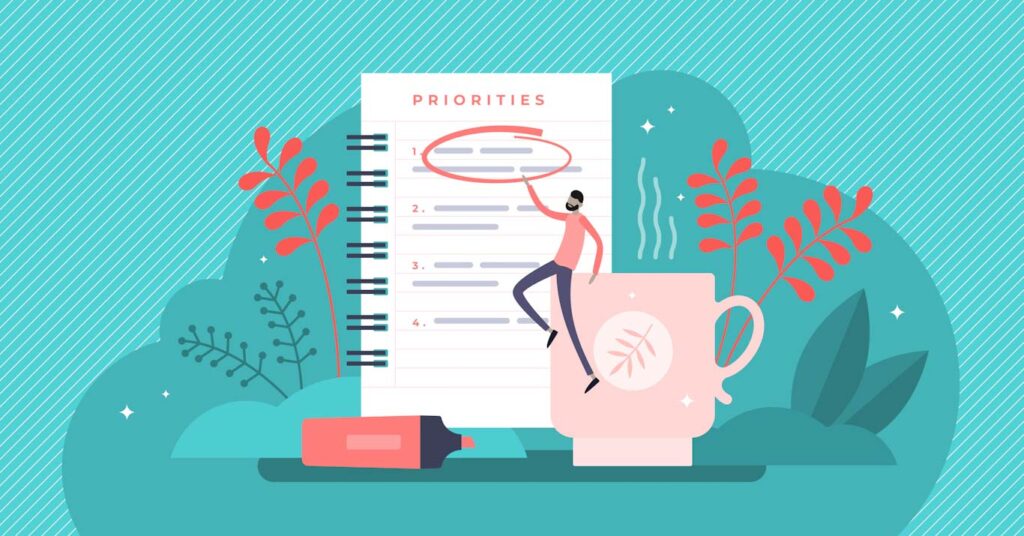
If you are a project manager, the success of your project and your team’s efficiency depend on how well you prioritize tasks. Whether you’re working on small or more complex projects, you need to understand the importance and urgency of each item on your to-do list. However, it’s not as easy as it seems. No matter how carefully planned a project is, tasks will be reordered and reprioritized according to unprecedented needs.
One of the biggest challenges you’ll face as a project manager is prioritizing tasks in day-to-day operations. Even with the help of the top project management tools, success still depends on the decisions you make.
In this article, you will find various time management and prioritization techniques that will keep you on top of your projects. We will help you hit those deadlines and even show you the best ways to alleviate the stress involved in the process.
The Best Methods for Prioritizing Tasks
When it comes to prioritizing tasks, it is important to break them down into the simplest activities. This means that you cannot afford to be vague in describing a task. It has to be specific and achievable. Moreover, you need to identify tasks that are dependent on others. This will help you create a more efficient schedule. Here are some of the best task prioritization methods that incorporate those principles:
Creating a Master List
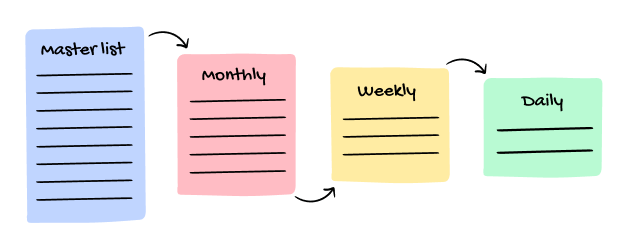
If you’re just starting on a project, the best method to manage tasks is by creating a master list. Once you’ve written down all your tasks, you can break them down into monthly, weekly, and daily targets. If tasks are just floating in the air, you won’t be able to prioritize them. Think of your master list as your brain dump. You can use a piece of paper, a spreadsheet, or a project management tool like JIRA to do this. What’s important is you can easily access and update the list when new priorities come up.
After creating a master list, you will notice which items require immediate attention. You will also notice the tasks that can be delivered within the week or month. You can start working off your master list while prioritizing the tasks according to your daily, weekly, and monthly goals. Pull your monthly tasks from the master list, then pull your weekly tasks from it, and so on. By looking at your tasks this way, you can have daily priorities that are aligned to your overall goals.
The ‘Eat That Frog’ Method
You’ll need strategic planning to use the Eat That Frog method. The name of this method came from a quotation from Mark Twain:
If it’s your job to eat a frog, it’s best to do it first thing in the morning. And if it’s your job to eat two frogs, it’s best to eat the biggest one first.
What this is saying is that you should finish the most important tasks first. Begin your day by identifying your objectives. You can evaluate your to-do list by looking from the perspective of your goals. If there are complex yet important tasks, make sure to work on them first. Once you’ve eaten the largest frog, you can move on to the smaller ones. With this method, you are prioritizing items based on your daily goals.
The Eisenhower Matrix
Anyone willing to learn how to prioritize their tasks has come across the Eisenhower Matrix. Many people talk about time management. However, the truth is, we can never control how time runs. All of us get 24 hours a day and 60 minutes for every hour. There is no way to manage time. What we can do is organize tasks, and the Eisenhower Matrix shows how to do that.
Indeed, your master list gives you an overview of how to prioritize your tasks. However, things can start to get complicated once you start deciding which ones to work on first. In this case, you’ll need to distinguish urgent tasks from important ones. Developed by former POTUS Dwight Eisenhower, the matrix is a box with four quadrants that let you identify which items require your immediate attention.
To put it simply, urgent tasks are items that you need to react to right away. Meanwhile, important tasks are those that contribute to your long-term goals and overall mission. When it comes to prioritizing tasks, you can look at the items this way:
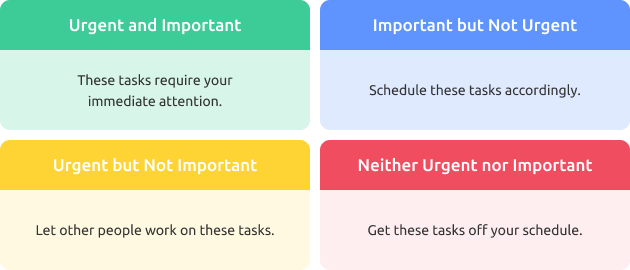
One of the challenges you will encounter is managing urgent but not important tasks. You can get them off your priority list if you know about smart delegation. This process starts with finding the ideal person for a task and explaining the responsibilities to them properly. However, this still involves providing the assignee with adequate guidance and support.
Brian Tracy’s ABCDE Method
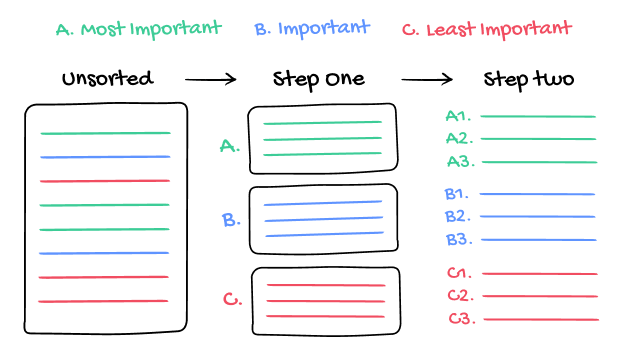
One of the challenges of prioritizing tasks is knowing the true importance of each item. When you try assessing each task, you might feel that they are on the same level of importance. When you’re juggling multiple duties or working on complex tasks, using the Eisenhower Matrix may not be the best option. In this case, Brian Tracy’s ABCDE method is the solution. Instead of assigning a single level of priority to a large group of tasks, this method provides sub-levels.
With the ABCDE method, you have to go through your master list, then rate the priority level of each task using a letter, with A being the highest priority and E the lowest. Now, under every major category, you will assign numbers to the tasks, indicating the order you will complete them. Keep doing this until you have assigned letters and numbers to all the tasks.
Chunking
Another efficient task prioritization method is chunking. A Stanford University study revealed that multitasking kills productivity and may even damage your brain. So, if you want to complete projects efficiently, you should divide days into chunks or blocks of time.
Once you’ve listed all your tasks, you must sort them based on context. Let’s say you’re managing a team of app developers. In this case, you would sort the tasks based on the back-end and front-end design activities. After identifying these two contexts, you will assign portions of time to both groups. By following this method, you can focus on the task for the current period. This way, you can avoid constantly being distracted by anything that comes up.
Use a Time Tracker to Identify Your Ultradian Cycles
One of the best ways to boost your productivity is by identifying your peak hours and prioritizing your tasks around those periods. All of us naturally go through hills and valleys of focus and energy. However, there are certain times of day when we feel more productive. Also known as an ultradian cycle, your peak productivity times usually last around 90 minutes. After that period, you will notice a drop in your energy and focus. However, taking regular breaks can help you recover and start another ultradian cycle.
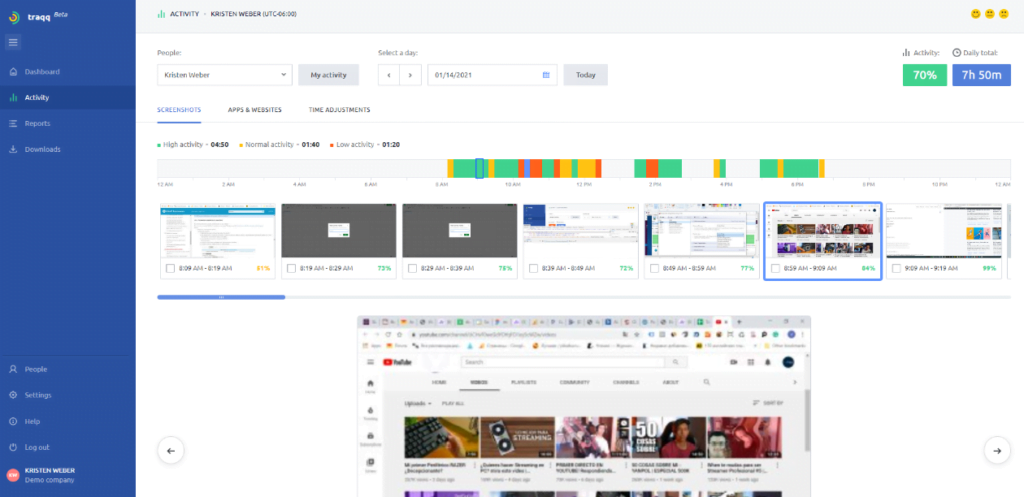
If you know your peak productive times, you can schedule high-priority tasks during them. This way, you can plan your day for maximum productivity. In this case, you’ll need a tool like Traqq. When you run this time tracker, it will monitor how you work throughout the day. Moreover, its dashboard provides you with in-depth reports on your activity levels. High, medium, and low activities are color-coded accordingly, allowing you to identify trends in your productivity.
The Bottom Line: Task Prioritization = Productive Work
When you know how to prioritize tasks, you can boost your productivity and improve your time management skills. However, no matter how carefully you plan your day, remember that interruptions can still happen. So, while you know how to recognize valuable work, you must still be realistic about the amount of output you can produce. This way, you can always feel good about the progress you make. Moreover, taking breaks won’t leave you with guilt.
